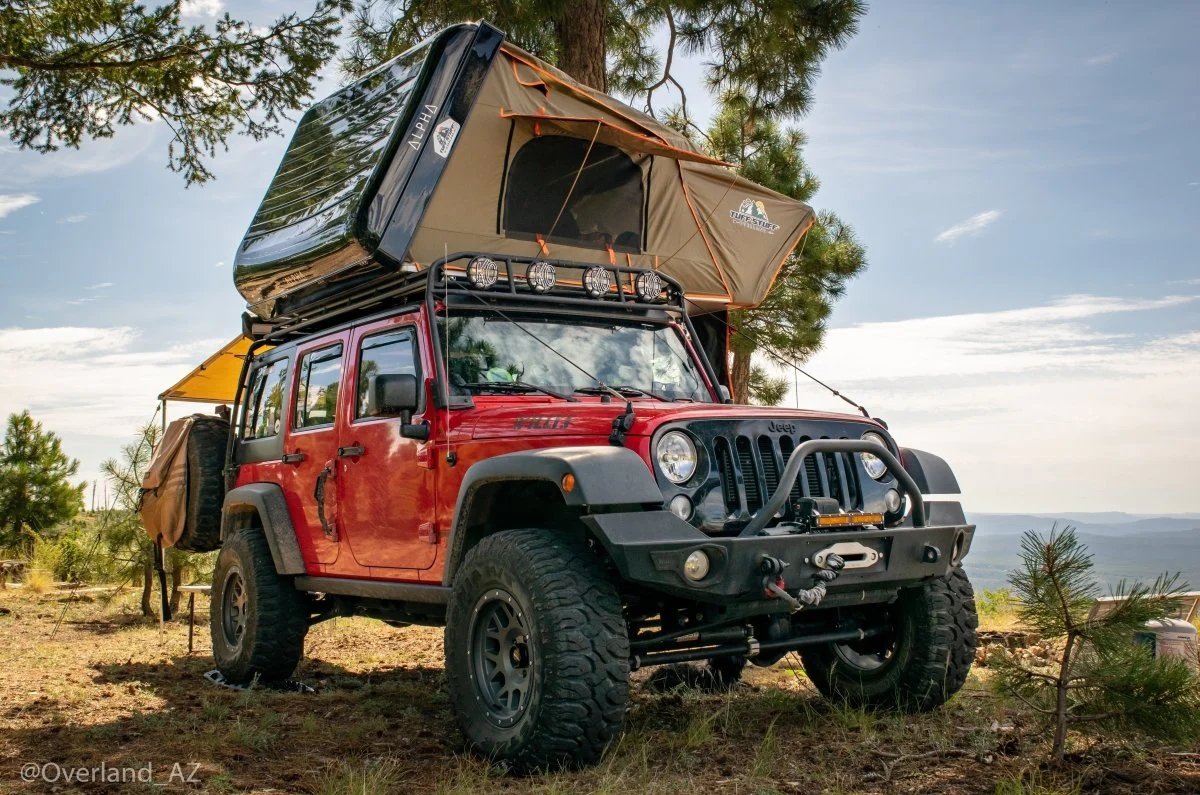Knowing how much rooftop tents impact gas mileage is a major concern for many campers. In a quest to attain the convenience rooftop tents offer, how fast will your car burn through fuel? Will there be a change in how much fuel you use, and if this happens, how drastic will this change be?
If you ask yourself important questions like these, this article is for you. Below, we have provided all the essential information you need to know about how rooftop tents affect your gas usage while camping on the go.

Rooftop Tent Fuel Usage
Rooftop tents have recently become an easy solution for camping on the go. With this ground-breaking camping gear, campers no longer have to worry about finding easy shelter in the wilderness and miles away from home.
Although rooftop tents are great for camping, one major concern about using this gear is how it affects a car. Seeing that rooftop tents are erected on the roof of a vehicle, many campers find themselves asking if this gear poses any risk to their vehicle.
Most importantly, many people want to know how latching a rooftop tent to the roof of their vehicle affects gas usage. Given the drastic increase in gas prices, this worry is logical and well-founded. So, how badly do rooftop tents impact gas mileage?
Knowing how much carrying a rooftop tent will affect your vehicle is a great way to monitor and measure your gas economy. This will help you track how much you spend on gas while also ensuring you are not stranded in the middle of nowhere because you misjudge how far the gas in your tank will take you.
While no scientific research has stated outrightly how much your mileage will suffer when you use a rooftop tent, there is data that can help you judge the impact of rooftop tents on your vehicle’s fuel.
When you use a rooftop tent, your gas mileage will inevitably take a hit to accommodate the heavier weight of the tent structure. However, the impact of rooftop tents on gas mileage varies with several factors. Some of these factors include:
- The type of vehicle you use
- How you drive
- The type of roof racks on your vehicle
- The size and type of rooftop tent you use
These factors influence how well your vehicle performs with a rooftop tent strapped on top of it.
1. Type of vehicle
Many campers who use rooftop tents do so with high-performing vehicles capable of conquering any terrain on their camping trips. These vehicles are usually 4WD, but sometimes, campers use 2WD with equally powerful features.
As long as your vehicle has high clearance with large tires that have great traction, a high-performing engine, and other great features, it is the perfect fit for your camping and overlanding trip.
Regardless of the vehicle you use on your camping trips, you need to understand that having a rooftop tent latched to your roof significantly affects your vehicle’s center of gravity. This influences several factors like your speed, momentum, and ability to make a turn or shift around a bend.
If you use an SUV, you are more likely to notice the effect of this change of gravity when you attach a rooftop tent to the roof of your car. Other than this general change, individual factors and features of your car play roles in how fast you burn through gas when you use a rooftop tent.
The model of your vehicle plays a role in determining how much gas it will consume. Although old models are often known to be the cheaper, more efficient, and more sturdy options for campers who find themselves crossing challenging terrains, they are not usually the best option for efficient gas consumption.
In many car brands, the newer options usually have their engine tweaked to make a better update that allows a better gas economy. When choosing a vehicle for your camping activities, especially one you intend to attach rooftop tents on, you must do your research and find out what the gas mileage is before you make that purchase.
One easy way to know how much gas mileage a car has is to use your vehicle’s onboard computer to do the calculation. Although you will get figures as close to correct as possible, gas mileage figures calculated by your vehicle’s computer are not usually accurate as they adjust over long distances.
For a more accurate number of your gas efficiency, you will need to do the calculation yourself. Gas mileage is calculated in miles per gallon (MPG) and is simply how many miles you can travel per gallon of gas. To calculate your car’s MPG:
- Fill up your gas tank to its capacity.
- Reset your trip odometer.
- Drive your car at the normal speed you travel.
- Use up at least half of the gas in the tank or simply wait until the gas light comes on and tells you that you need a gas refill.
- Take note of the total odometer reading.
- Fill your gas tank up again.
- Make a note of the number of gallons you buy this time.
- Reset the trip.
- Do the math by dividing the total number of miles you traveled by the number of gallons used (which is the same as the number of gallons you filled up the second time).
Knowing your gas efficiency without the added load of a rooftop tent will help track how much your gas usage is impacted when you use a rooftop tent.
2. Driving behavior
Your driving behavior plays a huge role in how much gas you use when you install a rooftop tent. With a rooftop tent strapped on the roof of your vehicle, your car’s center of gravity is altered.
It is burdened with more weight and will require more effort to maneuver. Not adapting your driving behavior to match the change in your vehicle’s center of gravity can reduce your vehicle’s mileage. Some of these behaviors include:
- Frequent braking and acceleration
- Going too fast
- Not making regular oil changes
- Not checking tire pressure
3. Type of roof racks on your vehicle
Roof racks do not look like they hamper a vehicle’s gas mileage, but in reality, your car takes an MPG hit when you install roof crossbars. Will your roof rack affect your gas mileage?
The short answer is yes. The long answer depends on several factors.
The most important factor determining how much your roof rack affects your MPG is the quality of the roof racks.
Roof racks come in different sizes and are made of different materials. Low-quality or poorly-made roof racks will disrupt your vehicle’s aerodynamics. This, in turn, can lower your gas mileage by up to 25 percent.
The easiest way to avoid this is to invest in high-quality roof racks perfectly built to fit your vehicle and work with its aerodynamics. With a good roof rack, you will experience between a 2-11% reduction in MPG.
4. Size and type of tent
Of course, the size and type of tent you purchase determine your vehicle's performance while driving. Before you purchase a rooftop tent, keep in mind that there are two types of tents which are soft-shell and hard-shell tents.
While both tents are great, they exert different influences on the vehicle they are installed on. Soft-shell tents look like your regular ground tents. They are often made from thick and durable materials with a rigid platform made of fiberglass or aluminum.
They are bulky with a soft outer shell that makes that easy to fold out to make a bigger living space. Hard-shell tents (like the TuffStuff Alpha II), however, are a more durable tent option made with better framing. They are constructed to be compact in a boxy structure that makes it easier to erect and close them down.
Besides their impressive material and structure, one more feature hard-shell rooftop tents have in common is that they are built in an aerodynamic design. When using a rooftop tent, one major concern is the increase in drag resistance. The drag resistance makes it more difficult to control your car, especially when you are moving against the direction of the wind.
This is one leading cause of increased gas mileage when campers install rooftop tents on the roof of their car. While this increase in drag resistance is unavoidable, hard-shell tents are built in a sleek design to reduce drag to a tolerable minimum.
This aerodynamic design is aesthetically pleasing and will save you hundreds of dollars of gas yearly. With soft-shell tents, the story is different. While they offer lots of room and are a cheaper alternative than hard-shell tents, soft-shell tents cause drag when strapped to the roof of your car.
They are not built in aerodynamic design and will ultimately reduce your gas mileage. Other than this, the weight of your tent also affects how much gas you use. The bigger your tent, the more it weighs. The average rooftop tent weighs between 100-200 LBS.
This might not look like much, but when you consider your car’s weight restrictions, the weight of your tent determines how much your gas mileage will be affected. So, taking these factors in hindsight, how much does a rooftop tent impact your car's MPG?
Some studies have shown that a vehicle’s fuel efficiency will drop by 17 percent when you install a rooftop tent. This is due to drag from the wind and added weight on the vehicle.

Does A Rooftop Tent Affect How Fast You Drive?
Although your fuel economy depletes, your speed doesn’t take a noticeable hit. You can drive as fast as you normally will. However, it is essential to remember that the faster you drive, the faster your fuel economy suffers.
Installing a rooftop tent on the roof of your vehicle alters your vehicle’s aerodynamic structure but does not affect its overall performance. Any sway or unbalance you feel as you hit the gas pedal is not because you are driving as you normally would but mostly because of the wind drag and change in the center of gravity.
This is only the case if the total weight of your rooftop tent doesn't surpass your vehicle’s weight capacity. Vehicle weight capacity is the total weight your vehicle can operate under. It is split into static weight capacity and dynamic weight capacity.
Static weight capacity, also known as static load capacity, is the amount of weight your vehicle can hold on its roof when it is not in motion. Because it is not moving, the load is spread evenly. This makes the static weight capacity of a vehicle substantially more than its dynamic weight capacity.
Dynamic weight capacity, however, is how much weight the roof can hold when the vehicle is in motion. Loading your vehicle with a rooftop tent heavier than its recommended limit will negatively impact how well you can handle your car.
The less control you have over your vehicle, the higher your chances of using more fuel to maneuver it. This will impact your ability to speed and make turns, putting you at risk if you try to drive as fast as you used to.
We recommend keeping your rooftop tent within your vehicle’s weight limit and maintaining a speed below 65MPH to minimize fuel depletion and ensure safety.
How To Reduce Gas Mileage
When a rooftop tent is installed on your vehicle, your gas mileage inevitably suffers. To prevent burning through fuel faster than necessary, it is essential to adjust your driving behavior and adopt fuel-efficient driving techniques. Some of these techniques are:
- Accelerate gently: the harder you floor the gas pedal, the more fuel you burn. Instead of jamming the pedal, slowly ease it down and take longer to accelerate than you normally do.
- Maintain your speed: avoid sudden braking or accelerating. Keep your speed steady.
- Don't drive too fast: the faster you drive, the more fuel you use. Admittedly, some vehicles are more fuel efficient than most. However, this rule still stands for many vehicles.
- Use less air conditioning: It might be time to crank the windows down. Try to use less air conditioning than you normally would, as air conditioning increases a vehicle’s fuel depletion by 20%.
- Track your fuel use: constantly reviewing your fuel consumption will keep you alert on your driving behavior.
What's The Final Ruling?
Although installing a rooftop tent on your vehicle can reduce your gas mileage by up to 17 percent, it is essential to note that there are ways you can reduce this negative impact.
By getting an aerodynamic rooftop tent, buying high-quality roof racks, and tweaking your driving behavior, you ensure your gas mileage doesn't suffer dangerous depletion.
Essentially, the first step in ensuring you protect your gas mileage is to install your rooftop tent properly. Don't know how to do this? Check out our guide on how to mount a rooftop tent properly.



